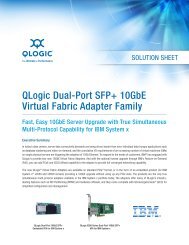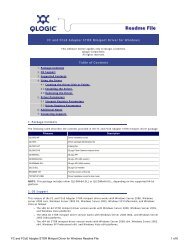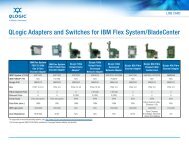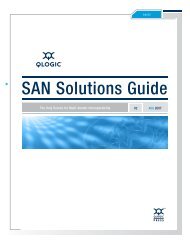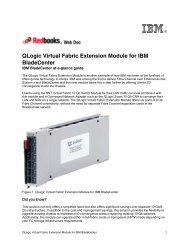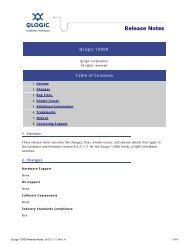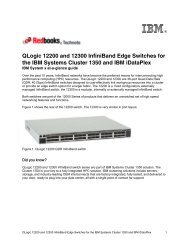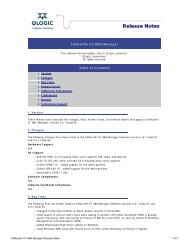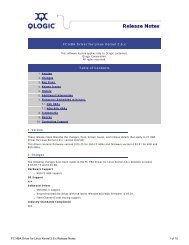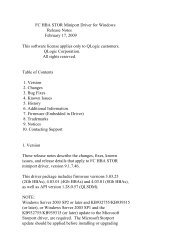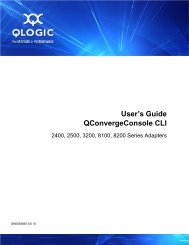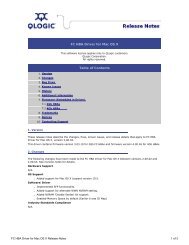Transparent Routing with QLogic Switches
Transparent Routing with QLogic Switches
Transparent Routing with QLogic Switches
Create successful ePaper yourself
Turn your PDF publications into a flip-book with our unique Google optimized e-Paper software.
Technology Brief<strong>Transparent</strong> <strong>Routing</strong> <strong>with</strong><strong>QLogic</strong> <strong>Switches</strong><strong>QLogic</strong>’s New, Flexible NPIV-based <strong>Transparent</strong> RouterFeatures Unify a Diverse SAN EnvironmentExecutive Summary<strong>Transparent</strong> <strong>Routing</strong> is a standard feature of <strong>QLogic</strong> ® series switches. <strong>QLogic</strong>’s <strong>Transparent</strong> <strong>Routing</strong> (TR) solution continues theindustry-standard NPIV revolution by making truly heterogeneous SANs a practical reality. Building on advantages already provenin the context of <strong>QLogic</strong>’s high volume OEM blade server switch sales, TR removes the vendor-to-vendor interoperability concernstraditionally associated <strong>with</strong> multi-platform storage networks.With TR, <strong>QLogic</strong> 5800 and 3800 Series <strong>Switches</strong> provide seamless, cost-effective expansion of SANs from <strong>QLogic</strong> or any other vendor.Existing services and management practices are preserved while new storage resources are attached via a state-of-the-art 8Gbinfrastructure. New and existing resources can be immediately shared across platforms <strong>with</strong>out disruption. E_port complexity iseliminated as the <strong>QLogic</strong> series switches become “transparent” to the original switch infrastructure. From the perspective of theexisting SAN, only the new hosts and storage devices are visible.This paper will examine TR and explain the benefits that help <strong>QLogic</strong> series switches <strong>with</strong> TR provide best-in-class flexibility and value.
Technology BriefCustomer Challenge: Create Competitive Advantage byRapidly Implementing New Technologies <strong>with</strong> Little orNo Disruptionvirtualization, arguably the greatest efficiency enhancement to occur inSANs for the past several years.Enterprise investments in IT infrastructure typically span a wide range ofproducts and providers—and storage network infrastructure investmentsare no exception. The constant availability of new technologies makeschange enticing, but it can also introduce new management burdens,cause interoperability problems, and place an increasing strain onlimited budgets.Nevertheless, ongoing IT enhancement remains a competitive necessityand cost-effective growth solutions must be found. The corporate SANenvironment must evolve, and during all evolutionary phases it must meetthese minimum requirements:••Non-disruptive Expansion: Service levels to end users must remainconstant••Investment Protection: Value of existing infrastructure must bepreserved••Operational Efficiency: Administration and management must becomeless, not more labor intensiveSolution: Flexible Strategies Based on NPIVN-Port Virtualization (NPIV) is a widely deployed ANSI T11 Fibre Channelstandard that allows multiple N_Port IDs to share a single physical N_Port. This standard, protocol-based, multi-layered addressing scheme isthe underlying building block for several highly beneficial developmentstraditionally used in virtualized host environments. <strong>QLogic</strong> has extendedthis benefit to the SAN fabric to allow customers to exploit open, multivendorfabrics. First, we examine the foundation of NPIV based on virtualserver environments.Figure 1: NPIV Enables Server VirtualizationSince their market introduction, <strong>QLogic</strong> Fibre Channel Host Bus Adaptershave used NPIV to allow end users to effectively virtualize Fibre ChannelHost Bus Adapter functionality such that each VM running on a server canshare a pool of Host Bus Adapters, yet have independent access to its ownprotected storage. The <strong>QLogic</strong> Fibre Channel Adapter NPIV implementationvirtualizes the physical adapter port, allowing a single physical FibreChannel Adapter-port to function as multiple logical ports. NPIV allows eachphysical port to support up to 256 virtual ports.Figure 2 illustrates the advantage of NPIV in a virtual SAN environment. NPIVI/O virtualization allows storage administrators to deploy virtual servers<strong>with</strong> <strong>QLogic</strong> Fibre Channel Adapter technology, creating VMs that aremore secure and easier to manage. Without NPIV, a storage administratorwould have to reconfigure fabric zone and LUN masking parameters duringserver migration.NPIV for Server VirtualizationServer virtualization is the abstraction of the physical computing resources,including the operating system (OS) from server applications in anenvironment that presents itself as a dedicated set of computing resourcesupon which an OS can run. Adopting server virtualization technologiesallows data centers to optimize and streamline deployment of theirenterprise applications. Server virtualization is made possible by the FibreChannel industry-standard NPIV functionality.Figure 2: Advantages of Server Virtualization <strong>with</strong> NPIVNPIV lets multiple virtual OS instances on the same physical machine havetheir own World Wide Port Name (WWPN), therefore allowing them to betreated as discrete entities by network devices. In other words, virtualmachines (VMs) can now share a single Host Bus Adapter and switch portwhile receiving individualized network services such as zoning (see Figure1). This capability has been a key element driving the popularity of serverNSG-WP12001 SN0430901-00 Rev. A 08/12 2
Technology BriefExtending NPIV Into the SAN Fabric <strong>with</strong><strong>Transparent</strong> <strong>Routing</strong><strong>QLogic</strong>’s use of NPIV technology does not stop at the host. By using NPIV<strong>with</strong>in the fabric as well, <strong>QLogic</strong> Fibre Channel Switch fabric ports can bemade to appear to any externally-connected Fibre Channel Switch as a hostHost Bus Adapter or N-port. Switch-to-switch E_port compatibility, domainID, and management issues are eliminated.Fabric-side NPIV enables full interoperability of the <strong>QLogic</strong> 5800 and3800 Series <strong>Switches</strong> <strong>with</strong> any vendor’s switch. Changes to existingmanagement approaches are not required. TR provides selective, securesharing of devices in both directions <strong>with</strong>out merging fabrics (see Figure 3).Step 1: Place one or more selected <strong>QLogic</strong> SB5800 or SB3800 Switchport(s) into TR mode and connect Fibre Channel cables between the <strong>QLogic</strong>and existing third-party switches. (For purposes of this brief, the third-partyswitch will be termed the “remote” switch.)Fabric InteractionThe remote switch accepts the <strong>QLogic</strong> TR port login as if it was a hostor storage device, not a switch. The <strong>QLogic</strong> switch displays as an N_portdevice in the remote switch’s name server.N“I see a newN_port”SB5800 TR port #3Brocade name serverFigure 4: Step 1 – Set the <strong>QLogic</strong> Port Type to “TR” using QuickTools or CLIFigure 3: NPIV Facilitates <strong>Transparent</strong> Router InteroperabilityTR technology is the next natural progression of NPIV, incorporating andmanaging NPIV at the switch-port level to provide full heterogeneous switchinteroperability. TR technology eliminates the support and managementchallenges of switch E-port interoperability and merged SAN fabrics of thepast to allow sharing of server and storage resources over multiple pathsbetween heterogeneous SANs.Multi-vendor SAN Interoperability Without the ComplexityStep 2: Map devices between fabrics (i.e., identify which <strong>QLogic</strong>-attacheddevices will communicate <strong>with</strong> which remote fabric devices). This processis very simple, as an easy-to-use menu of <strong>QLogic</strong>- and remote-attacheddevices is presented along <strong>with</strong> a list of available TR ports to use.Fabric InteractionZones called Inter-Fabric Zones (IFCs) are automatically created on the<strong>QLogic</strong> series switch to facilitate mapping of devices between the fabrics.This ensures that only specified devices on each fabric can communicate todevices on the other fabric. However, these zones will not be active until thecorresponding zoning is performed in the remote fabric (see the next step).<strong>QLogic</strong> 5800 and 3800 Series Fibre Channel <strong>Switches</strong> <strong>with</strong> TR providethe performance and port consolidation of an additional switch <strong>with</strong>outactually exposing the switch to the existing core SAN. TR is a standardfeature of <strong>QLogic</strong> 5800 and 3800 Series <strong>Switches</strong>, and it is enabled on aper-port basis. There is no need to dedicate a domain ID to interconnectan existing fabric. The <strong>QLogic</strong> solution provides a high level of security andaccess control, whereby only the customer-specified devices are visibleand shareable between fabrics.12Devicesattached to<strong>QLogic</strong>switch3Devices onBrocade fabricAvailable TRports on<strong>QLogic</strong> switch<strong>Transparent</strong> <strong>Routing</strong> in Three Easy Steps4TR is extremely easy to deploy, thanks to the included wizardbasedmanagement tools. A simple, three-step process provides thisunprecedented interoperability between heterogeneous SAN switches.Figure 5: Step 2 – Map Devices (Four Clicks in the TR Mapping Manager)NSG-WP12001 SN0430901-00 Rev. A 08/12 3
Technology BriefStep 3: Generate zoning commands for the existing Fibre Channel<strong>Switches</strong>The <strong>QLogic</strong> wizard automatically generates zoning commands for thispurpose (following the standard conventions of the vendor brand selected),which may be pasted directly into the remote fabric’s managementapplication for maximum convenience and deployment speed.Fabric InteractionBrocadeFigure 6: Step 3 – Zone Both Fabrics <strong>with</strong> Easy Zoning WizardOnce the inter-fabric zones are enabled on the remote fabric, communicationis immediately possible between the mapped devices according to themappings established in Step 2.ConclusionIt is imperative that organizations continue to evolve their IT environmentsto address new and emerging challenges. The pace of change is increasing,driving the need for performance <strong>with</strong> flexibility. Creating a unified SANenvironment is a critical component in making IT a competitive advantage.<strong>QLogic</strong>’s TR technology enables non-disruptive connection to an existingSAN infrastructure, and eliminates the support and management challengesof switch interoperability and merged SAN fabrics of the past. This innovativefeature facilitates the sharing of server and storage resources over multiplepaths between heterogeneous SANs. Future-proof your storage assets <strong>with</strong>the <strong>QLogic</strong> 5800 and 3800 Series Fibre Channel <strong>Switches</strong>.Not only does TR allow new technologies to be seamlessly implemented<strong>with</strong>in deployed infrastructure, it also provides another critical benefit. Byensuring greater choice and eliminating the necessity of lock-in to a singleproprietary vendor, TR boosts competitiveness, encourages innovation, andmotivates the market to keep system prices in check.Customers can now exploit the unique benefits of <strong>QLogic</strong> SANs throughthe use of TR by adding <strong>QLogic</strong> switches to any existing SAN. You cancreate inter-switch stacking links <strong>with</strong>out losing data ports, deploythe most cost-effective departmental switch, and enjoy truly simplemanagement <strong>with</strong> drag-and-drop zoning, wizards, and an intuitive usermanagement interface.With TR, <strong>QLogic</strong> allows customers to exploit open, multi-vendor fabrics.Now, you have the freedom of choice to eliminate vendor lock-in and takeadvantage of the most proven Fibre Channel stack in the industry.Follow us:Share:Corporate Headquarters <strong>QLogic</strong> Corporation 26650 Aliso Viejo Parkway Aliso Viejo, CA 92656 949-389-6000www.qlogic.comInternational OfficesUK | Ireland | Germany | France | India | Japan | China | Hong Kong | Singapore | Taiwan© 2012 <strong>QLogic</strong> Corporation. Specifications are subject to change <strong>with</strong>out notice. All rights reserved worldwide. <strong>QLogic</strong> and the <strong>QLogic</strong> logo are registered trademarks of <strong>QLogic</strong> Corporation. All other brand and product names are trademarks or registered trademarks of theirrespective owners. Information supplied by <strong>QLogic</strong> Corporation is believed to be accurate and reliable. <strong>QLogic</strong> Corporation assumes no responsibility for any errors in this document. <strong>QLogic</strong> Corporation reserves the right, <strong>with</strong>out notice, to make changes in product design or specifications.NSG-WP12001 SN0430901-00 Rev. A 08/12 4



